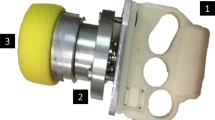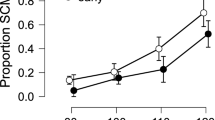Abstract
The aim of the study was to evaluate the possibility of estimating a startle response and sensorimotor gating based on changes in the range of vertical pressure force of the feet on the ground during a dynamometric examination. The study encompassed 13 healthy and physically fit men (age: 23.3 ± 2.0 years; height: 178.0 ± 6.1 cm; and weight: 76.1 ± 9.0 kg). The inhibitory mechanisms of startle reflex were used as the measure of sensorimotor gating. It was triggered by a strong acoustic stimulus (106 dB SPL, 40 ms), which was preceded by a similar, weaker signal (80 dB SPL, 20 ms). Startle reflex was evaluated using a piezoelectric force platform. The results of the conducted study show that the range of vertical pressure force of the feet caused by the reaction to a strong acoustic stimulus is significantly smaller when this stimulus is preceded by a signal of lower intensity (prepulse). Such assessment is only possible with the participants’ eyes open. The generalized startle response of a person may be estimated using a force platform, based on changes in the range of vertical pressure force of the feet on the ground, which are caused by unexpected acoustic stimuli. There is a strong indication that using a force platform to evaluate sensorimotor gating could be used as an alternative to electromyographic examinations.




Similar content being viewed by others
References
Davis M, File SE (1984) Intrinsic and extrinsic mechanisms of habituation and sensitization: implications for the design and analysis of experiments. Habituation Sensitization Behav:287–324
Koch M (1999) The neurobiology of startle. Prog Neurobiol 59:107–128
Błaszczyk JW (2003) Startle response to short acoustic stimuli in rats. Acta Neurobiol Exp 63:25–30
Wynn JK, Sergi MJ, Dawson ME et al (2005) Sensorimotor gating, orienting and social perception in schizophrenia. Schizophr Res 73:319–325
Ewing SG, Grace AA (2013) Evidence for impaired sound intensity processing during prepulse inhibition of the startle response in a rodent developmental disruption model of schizophrenia. J Psychiatr Res 47:1630–1635
Quednow BB, Frommann I, Berning J et al (2008) Impaired sensorimotor gating of the acoustic startle response in the prodrome of schizophrenia. Biol Psychiatry 64:766–773
Takahashi H, Iwase M, Ishii R et al (2008) Impaired prepulse inhibition and habituation of acoustic startle response in Japanese patients with schizophrenia. Neurosci Res 62:187–194
Wu R, Song L, Lü J et al (2015) Prepulse inhibition of startle reflex in schizophrenics and healthy adults. Zhonghua Yi Xue Za Zhi 95:823–826
Ueki A, Goto K, Sato N et al (2006) Prepulse inhibition of acoustic startle response in mild cognitive impairment and mild dementia of Alzheimer type. Psychiatry Clin Neurosci 60:55–62
Zoetmulder M, Biernat HB, Nikolic M et al (2014) Sensorimotor gating deficits in multiple system atrophy: comparison with Parkinson’s disease and idiopathic REM sleep behavior disorder. Parkinsonism Relat Disord 20:297–302
Zoetmulder M, Biernat HB, Nikolic M et al (2014) Prepulse inhibition is associated with attention, processing speed, and 123I-FP-CIT SPECT in Parkinson’s disease. J Park Dis 4:77–87
Kiziltan ME, Gunduz A, Apaydın H et al (2015) Auditory startle reflex and startle reflex to somatosensory inputs in generalized dystonia. Clin Neurophysiol 126:1740–1745
Madsen GF, Bilenberg N, Jepsen JR et al (2015) Normal P50 gating in children with autism, yet attenuated P50 amplitude in the asperger subcategory. Autism Res 8:371–378
Aluja A, Blanch A, Blanco E, Balada F (2015) Affective modulation of the startle reflex and the reinforcement sensitivity theory of personality: the role of sensitivity to reward. Physiol Behav 138:332–339
Moriwaki M, Kishi T, Takahashi H et al (2009) Prepulse inhibition of the startle response with chronic schizophrenia: a replication study. Neurosci Res 65:259–262
Schumacher S, Schnyder U, Furrer M et al (2013) Startle reactivity in the long-term after severe accidental injury: preliminary data. Psychiatry Res 210:570–574
Takahashi H, Iwase M, Yasuda Y et al (2012) Relationship of prepulse inhibition to temperament and character in healthy Japanese subjects. Neurosci Res 72:187–193
Kandemir M, Gündüz A, Uzun N et al (2015) Auditory startle response is normal in juvenile myoclonic epilepsy. Neurol Sci 36:1247–1249
Kumru H, Opisso E, Valls-Solé J, Kofler M (2009) The effect of a prepulse stimulus on the EMG rebound following the cutaneous silent period. J Physiol 587:587–595
Brown P, Day BL, Rothwell JC et al (1991) The effect of posture on the normal and pathological auditory startle reflex. J Neurol Neurosurg Psychiatry 54:892–897
Błaszczyk JW, Tajchert K (1997) Effect of acoustic stimulus characteristics on the startle response in hooded rats. Acta Neurobiol Exp (Warsz) 57:315–322
Daldrup T, Remmes J, Lesting J et al (2015) Expression of freezing and fear-potentiated startle during sustained fear in mice. Genes Brain Behav 14:281–291
Hillman CH, Hsiao-Wecksler ET, Rosengren KS (2005) Postural and eye-blink indices of the defensive startle reflex. Int J Psychophysiol 55:45–49
Polechoński J, Juras G, Słomka K et al (2016) Assessment of startle response and its prepulse inhibition using posturography: pilot study. Biomed Res Int 2016:1–5
Grillon C, Ameli R, Charney DS et al (1992) Startle gating deficits occur across prepulse intensities in schizophrenic patients. Biol Psychiatry 32:939–943
Nashner L, Berthoz A (1978) Visual contribution to rapid motor responses during postural control. Brain Res 150:403–407
Palus WM, Straube A, Brant T (1984) Visual stabilization of posture. Physiological stimulus characteristics and clinical aspect. Brain 107:63
Collins JJ, De Luca CJ (1995) The effects of visual input on open-loop and closed-loop postural control mechanisms. Exp Brain Res 103:151–163
Sienkiewicz H (2001) The comparison of stabilogram courses for human keeping balance after the elimination of some sense functions. Hum Mov 2:39–50
Rankin CH, Abrams T, Barry RJ et al (2009) Habituation revisited: an updated and revised description of the behavioral characteristics of habituation. Neurobiol Learn Mem 92:135–138
Pęciłło M (2016) The concept of resilience in OSH management: a review of approaches. Int J Occup Saf Ergon 22:291–300
Henderson D, Lary A, Burrell LM, Matthews MD (2011) Assessing the comprehensive soldier fitness program: measuring startle response and prepulse inhibition. DTIC Document. http://www.dtic.mil/get-tr-doc/pdf?AD=ADA540676. Accessed 14 May 2017
Polechoński J, Błaszczyk J (2006) The effect of acoustic noise on postural sway in male and female subjects. J Hum Kinet 15:37
Funding
This research received no specific grant from any funding.
Author information
Authors and Affiliations
Corresponding author
Ethics declarations
Conflict of interest
The authors declare that they have no conflict of interest.
Ethical approval
All procedures performed in studies involving human participants were in accordance with the ethical standards of the institutional and/or national research committee and with the 1964 Helsinki declaration and its later amendments or comparable ethical standards.
Rights and permissions
About this article
Cite this article
Polechoński, J., Nawrocka, A., Juras, G. et al. Evaluation of startle response and prepulse inhibition based on changes in the range of vertical pressure force of the feet on the ground: a preliminary study. Neurol Sci 38, 2139–2143 (2017). https://doi.org/10.1007/s10072-017-3129-9
Received:
Accepted:
Published:
Issue Date:
DOI: https://doi.org/10.1007/s10072-017-3129-9




